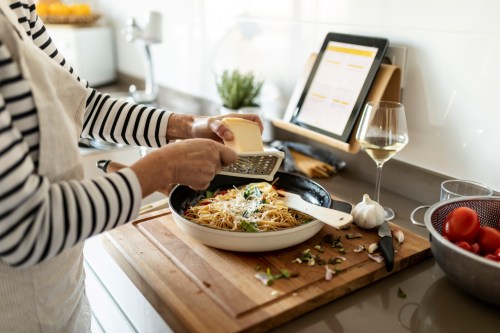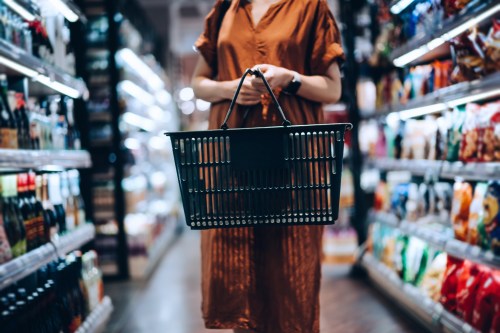Our editors independently select these products. Making a purchase through our links may earn Well+Good a commission
You Gotta Eat: Food Writer Margaret Eby’s Advice for Fueling Yourself in Stressful Times
The upcoming months can feel overwhelming, but author Margaret Eby offers tips to help you nourish yourself even when cooking feels daunting.

Between daylight saving time, menu planning, the election (and post-election), gift-getting, and holiday travel, the months ahead are really starting to feel like Too Much. When thinking about managing my own mental health, I focus on sleep hygiene, getting some sunlight, and reducing my screen time. While these are typically top priorities with a lot of mental health experts weighing in, there’s not a ton of information on what to do when my stomach hurts so much I don’t want to eat, let alone stand in the kitchen and chop something for five minutes (and I say that as someone who has worked in and around food my whole life).
But wherever you fall on your want-to-eat-or-can’t-eat spectrum, making sure you’re getting some form of nutrition—without completely overexerting yourself when you don’t have the energy—is required. Simply put: You gotta eat. Our bodies and brains need carbohydrates, fat, and protein to keep us going, even if that “going” is simply from the bed to the couch.
Luckily for us, journalist and food critic Margaret Eby’s debut cookbook: You Gotta Eat: Real Life Strategies For Feeding Yourself When Cooking Feels Impossible, out November 19, aims to help us to do just that. A professionally trained cook and a seasoned food writer, Eby understands the weight of preparing food on repeat, and how, if you’re not in the best headspace, it can compound to a place that feels overwhelming—even if you love cooking and your kitchen is typically your safe space.
Sure, there’s always DoorDash, but if you’re someone who actually wants to cook, we’ve got options for you that won’t leave you feeling overextended. “People have been figuring out how to feed themselves under adverse conditions as long as there have been people,” Eby told Well+Good.
Eby—who has openly discussed her experience with depression and anxiety—has spent much of her career touching food, talking about food, and writing about food, all while navigating her relationship with food and her mental health. As a professional cook, she—like me—loves food, but when stress and anxiety take the forefront, Eby says getting back into the kitchen doesn’t always feel as good as she’d like.
If you’re finding yourself stressed, falling out of love with the act of cooking, or just needing a bit of a pep talk lately, Eby understands. Sometimes, a meal is two ingredients and a microwave— something just to “get you to the next meal and keep your soul and body together,” she says.
As someone who has very much been in a microwave era of exhaustion and anxiety, I can understand the push-pull that comes with wanting to cook—and wanting to do literally anything other than feed yourself. So trust me when I say that reading Eby’s You Gotta Eat was like reading Chicken Soup for the Soul as if it were written by all your favorite chefs…who are also hugging you in the process. And until you can find the energy to read for yourself, Eby was kind enough to share with Well+Good some of her favorite advice, as well as some extra guidance that she follows when she’s also feeling overwhelmed.
Remember that food can be just for you
Eby describes this food paradigm as being a double-edged sword, even as a food professional. “I care about it deeply and some days I’m thinking: ‘Cheese rind help me, I cannot possibly do it,’” she says.
Her biggest tip? Be patient with your food choices when you’re not feeling your best. “For example, if I’m feeling really bad, I’m not thinking, ‘Oh, it’s only organic produce for me;’ it’s box mac and cheese time,” she admits. “That’s okay, and you’ll get yourself back to where you want to be eventually.”
As much as food can seem difficult some days, it can also be so comforting and celebratory. “It’s so telling to me that the dish I think about all the time from The Bear is the omelet she makes with the crumbled up chips on top,” Eby muses. “It’s so loving and it’s exactly what this person asked for…this is what it means to have a little food knowledge.”
Forget the small stuff
A hurdle to cooking can be hyper-fixating on small details and getting them exactly as the recipe says. And sometimes, according to Eby, it’s really not that big of a deal for certain ingredients. “If you’re putting down 5 ounces of baby spinach… how many [handfuls] is that really?” says Eby. “It was helpful for me to say, if you have a little more spinach, or a little less, this dish is still going to be dinner—you’re good.”
Don’t worry about cooking for the ‘gram
For Eby, not every meal has to be “beautiful or perfect or interesting,” she says; “it simply has to get you to the next meal and keep your soul and body together.” Which, you know, is great advice when you’ve seen your sixth TikTok about a viral recipe that has upwards of 20 ingredients.
The differences between social-media perception and how people act in real life is “something we have to keep focusing on,” Eby notes. “It’s so easy to trick yourself into feeling bad,” she says, “in your kitchen you shouldn’t have to feel that way.”
Throw advanced techniques out the window
Sure, sometimes when you’re feeling up to it, it can feel really exciting to pull off something that feels straight out of the technical challenge on The Great British Bake Off. But when you just gotta eat, that can feel like a hindrance more than an exciting endeavor.
“There’s this [misconception],” says Eby, “that to be competent in the kitchen, you have to be doing all of these things,” like sous viding a steak, making complicated sauces, or garnishing your soups—you know, all the stuff you’d see on a cooking show. But remember, you don’t have to do any of it. Ever. “I have incredible news for you,” she says, “Your kitchen is none of those places and you don’t need to adhere to any of those rules.”
Eby’s book breaks down feeding yourself into five sections, based on how much energy you have for food and cooking at the moment: Opening Something, Assembling Something, Microwaving Something, Blending Something, and Cooking Something. Below, Eby shares some ways you can assemble, blend, or cook something that feels good for you, wherever you’re at.











